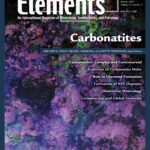
Carbonatites, October 2021, Vol. 17, No. 5
June 28, 2024
Cement And Concrete: From The Romans To Mars, October 2022, Vol. 18, No. 5
June 28, 2024Organic Biomarkers, April 2022, Vol. 18, No. 2
$20.00
Biomarkers are molecular fossils that are preserved in a wide range of environmental archives (e.g.
Organic Biomarkers
April 2022, Vol. 18, No. 2
Biomarkers are molecular fossils that are preserved in a wide range of environmental archives (e.g., soils, sediments, sedimentary rocks, and petroleum systems). This issue introduces biomarkers and their compound-specific stable isotope compositions to study fundamental biogeochemical processes and their application as proxies for environmental and climate reconstructions. Molecular biosignatures can be used to study the evolution of life, transitions in ocean plankton over time, the microbiota of extreme environments such as hydrothermal systems and the deep crustal biosphere, and to search for signs of life beyond Earth. Important new discoveries are typically the result of the development and deployment of improved instrumental techniques, multidisciplinary research approaches, and the combination of organic biogeochemistry with the new tools of molecular biology.
Why You’ll Love Elements Magazine:
- Expert Contributors: Articles written by renowned researchers in the field of geoscience.
- Engaging Content: Join a community of readers who are passionate about Elements.
- Exceptional Quality: Each issue is printed on high-quality paper with stunning visuals and detailed illustrations that bring complex scientific concepts to life.
Order your copy of the April 2022 issue of Elements magazine today and explore organic biomarkers.
Related products
-
Frontiers In Textural And Microgeochemical Analysis, August 2007, Vol. 3, No. 4
$20.00Recent advances have been made in high-resolution in situ methods to image mineral growth patterns, analyse compositional and isotopic zonation, and improve our ability to visualize, study, and model rock textures in three dimensions. These advances provide a significant step forward in the understanding of how rocks form and the history they can tell us.
-
Arsenic, April 2006, Vol. 2, No. 2
$20.00Arsenic is an element known throughout history as a classic poison. Currently, very small but highly significant concentrations of this element in drinking water supplies are causing massive health problems to many millions of people in some of the world’s poorest nations, and more localised sources related to mining and processing are also a concern.
-
Diamonds, March 2005, Vol. 1, No. 2
$20.00Diamond, the fascinating ultrahard mineral, is the focus of considerable interest and scientific research. Recent advances particularly relevant to geoscientists include: diamond as a recorder of Earth processes from the perspective of inclusions, chemistry, and conditions of formation; synthesis for research applications and processing to modify color and physical properties, important to diamond gems and anvils; the implications of nanodiamonds from meteorites.




